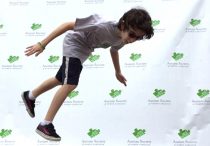
Why We Love This Video About Autism
A fourth grader named George Yionoulis took to YouTube to explain his autism to his classmates—and his efforts soon became a viral video. The project began as a presentation assignment from his teacher. Instead of standing in front of the class and talking about himself, George decided to create a music video.
In the brave and hilarious video, George tells his story without holding anything back, tackling a wide variety of autism-related topics including meltdowns, sensory overload, hand-flapping, and other issues and behaviors associated with autism. In the end, he reminds his classmates that, ultimately, he’s a “kid just like them” so they shouldn’t feel afraid to interrupt him, ask him to play, or ask him questions about autism.
Hearing stories from children with autism, in their own language, is an invaluable resource for all of the behavioral work we do at the Springbrook Autism Program.
It’s easy to get caught up in the medical and behavioral aspects of autism and forget the human element. While evidence-based treatments and therapies will always be the cornerstone of any effective autism program, the vast majority of these therapies rely on patient histories, ongoing surveys and interviews, and other clinical data.
For instance, in this video, George describes his impulse to flap his hands or pump his legs as a reaction to feeling too much excitement all at once. Knowing this behavioral trigger, if George and his parents were concerned about this behavior and wanted to minimize it, we could use storyboards to introduce exciting topics gradually, visual schedules to remind George of upcoming events, and positive reinforcement when he redirects his excitement. However, since the behavior doesn’t seem to be causing any harm, we would likely advise his parents not to worry about it—to see the behavior as their son’s way of communicating excitement and gratitude.
What About Nonverbal or Minimally Verbal Children With Autism?
There’s no doubt that George demonstrates well-developed social skills and verbal ability, including the capacity for playing with language and using humor to make his points. For the nonverbal or minimally verbal child with autism; however, there are still methods we can use to communicate with the child and use context clues to understand the child’s needs.
In many cases, the concerning behaviors themselves are an attempt to communicate on the part of the nonverbal child. For example, as was shown in this video, hand-flapping could be a response to over-excitement or it could be a sign of panic or frustration. Often, self-injurious behaviors indicate that the child has some pain or discomfort in the area that is being harmed—issues such as headaches, stomach issues, dizziness, and jaw pain can all lead to self-harming or maladaptive behaviors. Once we isolate the cause, using visual aids, storyboards, gestures, and augmentative communication devices, we can usually minimize the behavior.
Ultimately, the key principle to remember is that any attempt to communicate on the part of the child is good and beneficial—whether that attempt is a funny, heartwarming viral video or what seems, on the surface, to be a destructive or even embarrassing behavior. Both are clues to the child with autism and help us do our work more effectively.
Do you want to better understand your child and be able to interpret his or her behaviors? We can help. Call us at (864) 834-8013 for a confidential consultation.
Resources:
https://www.cbsnews.com/news/im-a-kid-just-like-you-9-year-old-boy-explains-autism-in-viral-video/
https://www.youtube.com/watch?time_continue=101&v=YIK2yXfrCfw